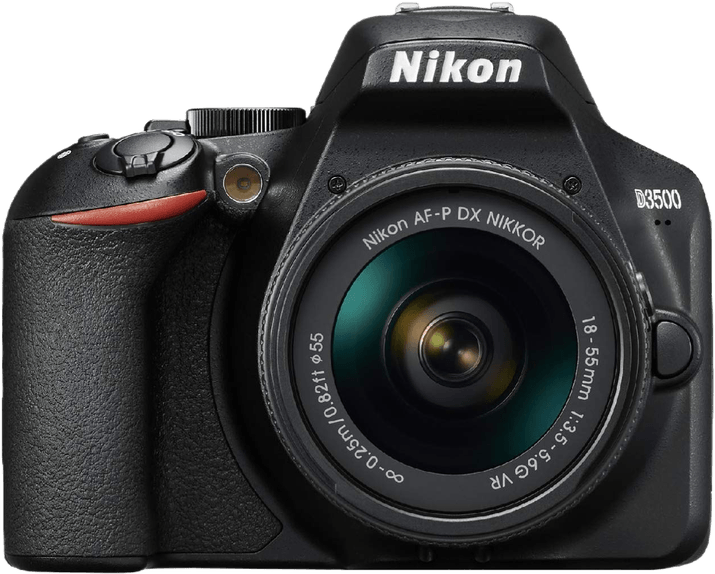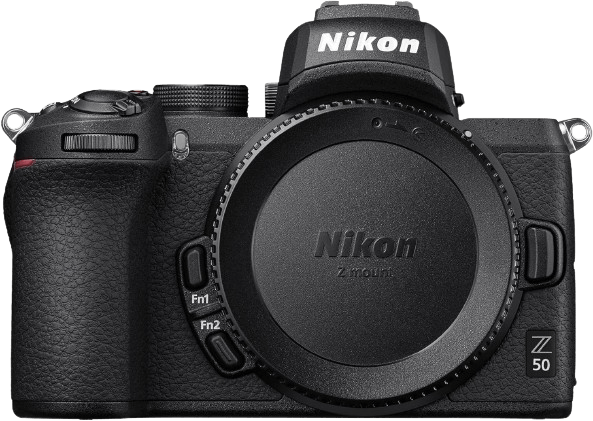Nikon D3500 vs Z50 Comparison
Nikon D3500

Nikon Z50

The Nikon Z50 emerges as the winner with a score of 73/100, while the Nikon D3500 scores 61/100. Both cameras were announced in 2018 and 2019, respectively, and share a few common specs. They both have the same launch price and similar camera sizes. The Z50 measures 127 x 94 x 60mm, while the D3500 measures 124 x 97 x 70mm.
The Z50 outperforms the D3500 in terms of weight, as it is significantly lighter at 450g compared to the D3500’s 615g. This makes the Z50 more portable and easier to handle. Additionally, the Z50 is a mirrorless camera, which contributes to its compact size and weight advantage.
On the other hand, the D3500 is a DSLR camera, which may appeal to those who prefer an optical viewfinder and a more traditional camera experience. However, the heavier weight and lower score make it less attractive compared to the Z50.
Considering the above points, the Nikon Z50 is the better choice due to its higher score, lighter weight, and compact size. The Nikon D3500 may still appeal to some users, but the Z50’s advantages make it the clear winner.
Nikon D3500 vs Z50 Overview and Optics
The Nikon Z50 outperforms the Nikon D3500 in optics, with a score of 72/100 compared to the D3500’s 65/100. Both cameras share some common specifications, including a CMOS sensor, APS-C sensor size, and lack of image stabilization. However, there are key differences that contribute to the Z50’s superior optics.
The Nikon Z50 has a faster shooting speed of 11 frames per second, more than double the D3500’s 5 frames per second. This allows the Z50 to capture fast-moving subjects with greater ease. Additionally, the Z50 boasts a more advanced Expeed 6 processor, compared to the D3500’s Expeed 4 processor, leading to better image processing and overall performance.
Furthermore, the Z50’s sensor has a DXOMARK score of 97, ten points higher than the D3500’s score of 87. This indicates that the Z50’s sensor is better at capturing detail and color accuracy. The Z50 also features a Nikon Z lens mount, which provides access to a wider range of lenses, compared to the D3500’s Nikon F lens mount.
On the other hand, the Nikon D3500 has a higher megapixel count of 24, compared to the Z50’s 21. This means that the D3500 can produce larger and more detailed images. However, the difference in megapixels is not significant enough to outweigh the advantages offered by the Z50’s superior optics.
In the end, the Nikon Z50’s faster shooting speed, advanced processor, better sensor, and wider lens compatibility make it the clear winner in terms of optics. The D3500’s higher megapixel count provides a slight advantage, but it is not enough to surpass the Z50’s overall performance.
Nikon D3500 vs Z50 Video Performance
The Nikon Z50 outperforms the Nikon D3500 in video capabilities, with a video score of 91/100 compared to the D3500’s 56/100. This significant difference in scores highlights the superior video features of the Z50.
Both cameras share some common video specifications, such as the ability to record video in Full HD resolution. However, the Z50 surpasses the D3500 with its 4K video resolution and maximum video dimensions of 3840 x 2160. This higher resolution allows for more detailed and clearer video footage, making the Z50 a better choice for those prioritizing video quality.
The Nikon Z50 also has a higher maximum video frame rate, reaching 120fps compared to the D3500’s 60fps. This increased frame rate allows for smoother and more dynamic video recording, particularly when capturing fast-moving subjects or creating slow-motion effects.
Another advantage the Z50 holds over the D3500 is its built-in time-lapse functionality. This feature enables users to easily create stunning time-lapse videos without the need for additional equipment or software, further enhancing the Z50’s video capabilities.
While the Nikon D3500 does not offer any notable advantages over the Z50 in terms of video features, it may still be a suitable choice for those who primarily focus on photography and only require basic video functionality.
Considering the significant differences in video specifications, the Nikon Z50 is the clear winner for those seeking superior video performance. Its 4K resolution, higher frame rate, and built-in time-lapse functionality make it a more versatile and capable camera for capturing high-quality video content. On the other hand, the Nikon D3500 may still suffice for users who only need basic video capabilities and prioritize photography.
Nikon D3500 vs Z50 Features and Benefits
The Nikon Z50 emerges as the winner in the comparison of features, with a score of 86/100, while the Nikon D3500 trails behind with a score of 54/100. Both cameras share some common specifications, such as the lack of GPS and the inclusion of Bluetooth connectivity.
The Nikon Z50 outperforms the D3500 in several aspects. The Z50 boasts a larger screen size of 3.2 inches, compared to the D3500’s 3-inch screen. Additionally, the Z50’s screen resolution is higher at 1,040,000 dots, compared to the D3500’s 921,600 dots. The Z50’s touchscreen functionality and flip screen provide a more user-friendly experience, making it easier to navigate menus and compose shots from various angles. Furthermore, the Z50 includes Wi-Fi capabilities, allowing for seamless sharing and transfer of images.
On the other hand, the Nikon D3500 has limited advantages over the Z50. While both cameras lack GPS, the D3500 shares the same Bluetooth connectivity as the Z50. However, this is not enough to compensate for the D3500’s shortcomings in other areas.
Taking into account the differences in features, the Nikon Z50 proves to be the superior camera. The larger screen size, higher screen resolution, touchscreen, flip screen, and Wi-Fi capabilities contribute to a more convenient and enjoyable shooting experience. The Nikon D3500, though offering Bluetooth connectivity, falls short in comparison to the Z50’s comprehensive feature set. Therefore, the Nikon Z50 is the better choice for photographers who prioritize advanced features and ease of use.
Nikon D3500 vs Z50 Storage and Battery
The Nikon D3500 triumphs over the Nikon Z50 in storage and battery with a score of 48 out of 100, compared to the Z50’s 35. Both cameras share similarities, such as having a single memory card slot and accepting SD, SDHC, and SDXC memory cards. However, the D3500 pulls ahead with its impressive battery life of 1550 shots, significantly outlasting the Z50’s 320 shots, and using the EN-EL14a battery type.
Conversely, the Nikon Z50 has a notable advantage in its compatibility with UHS-I memory cards and USB charging capability, which the D3500 lacks. This allows for faster data transfer and convenient charging options.
Despite the Z50’s added features, the D3500’s superior battery life makes it a more reliable option for extended photography sessions. The Z50’s USB charging and UHS-I support may appeal to some users, but the D3500’s longer-lasting battery ultimately gives it the edge in storage and battery performance.
Alternatives to the Nikon D3500 and Z50
Are you still undecided about which camera is right for you? Have a look at these popular comparisons that feature the Nikon D3500 or the Nikon Z50:

